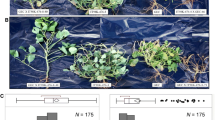Abstract
There are both economic and environmental reasons for reducing the use of herbicides for weed control in soybean [Glycine max (L.) Merr.] fields. Optimizing crop competitiveness can reduce reliance on chemical weed control. Fast and vigorous early growth and rapid canopy development can be effective in suppressing weed infestation of crop plants. The purposes of this study were to identify and molecularly map the quantitative trait loci (QTLs) conditioning soybean plant height and canopy width during the early vegetative stages of soybean growth. A restriction fragment length polymorphism (RFLP) linkage map was created using 142 markers and 116 F2-derived lines from a cross of ‘S100’בTokyo’. The parents and the 116 F2-derived lines were evaluated in the greenhouse and in the field at Athens, Ga., in 1996 and 1997. Combined over environments, Tokyo averaged 41 and 17% taller plants than S100 at the V7 and V10 stages of development. Transgressive segregation was observed among the progeny at both stages. Based on single-factor analysis of variance (ANOVA), three and four independent RFLP loci were associated with plant height at the V7 and V10 stages, respectively. All three loci detected [on linkage groups (LGs) C2 and F, and unlinked] at the V7 stage were also detected at the V10 stage along with one additional independent locus on LG E. The Tokyo allele contributed to increased plant height at all loci except at the unlinked locus. Three QTLs (on LGs C2, E, and F) were consistent across environments, three (on LGs C2 and F, and unlinked) were consistent across stages of plant development, and two (on LGs C2 and F) were consistent both across environments and stages of plant development. Within each stage of development, there was no interaction among the independent loci, and the respective loci together explained most of the variation in the traits. Three independent RFLP loci were associated with canopy width at the V10 stage, of which one was unique to the trait, while the remaining loci (on LGs C2 and F) were in common with the independent loci for plant height. Canopy width had a strong correlation (r=0.87) with plant height at the V10 stage. However, mature plant height, lodging, or seed weight had no phenotypic or QTL association with early plant height or canopy width.
Similar content being viewed by others
Author information
Authors and Affiliations
Additional information
Received: 10 May 1998 / Accepted: 13 July 1998
Rights and permissions
About this article
Cite this article
Mian, M., Ashley, D., Vencill, W. et al. QTLs conditioning early growth in a soybean population segregating for growth habit. Theor Appl Genet 97, 1210–1216 (1998). https://doi.org/10.1007/s001220051012
Issue Date:
DOI: https://doi.org/10.1007/s001220051012




